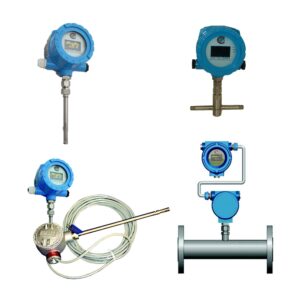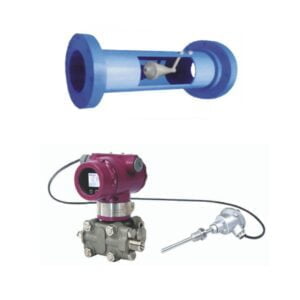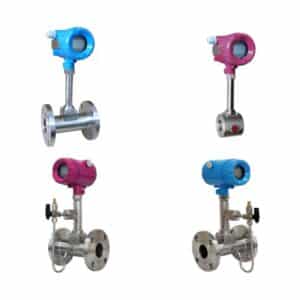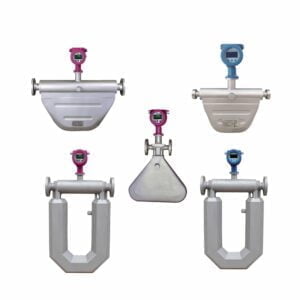Featured Products
Thermal Flow Meters

The most common mass flow meter used for gases are thermal flow meters, or thermal dispersion flow meters the SmartMeasurement ATMF series. The ATMF utilizes constant temperature difference method of measuring Gas Mass Flow Rate. It contains two reference grade platinum RTD sensors clad in a protective 316 SS sheath. Features direct Mass Flow for gases, wide rangeability, low pressure drops, very low-end sensitivity, and no moving parts. The ATMF series is microprocessor based, does not have any potentiometers. Electronics can be Integral Style or remote mount with rugged windowed dual compartment enclosure with local or remote display. Four models are available from the low-cost blind meters to the more exotic featured SP models. Calibration Self Check: Flow Meter has built-in diagnostics – a display of the calibration milliwatts (mW) can be used to check the sensor’s operation by being compared to the original reported “zero flow” value noted on the meter’s Certificate of Conformance (last few lines) and metallic tag. This convenient in-situ field diagnostic procedure verifies that the original factory calibration hasn’t drifted, shifted, or changed. This “Sensor Functionality and Zero Self Check” also verifies that the sensor is free from contamination, even without inspection.
Acone

The SmartMeasurement Acone differential flowmeter is designed for the harshest operating environments and for the widest variety of fluids, which consistently outperforms traditional DP devices and other major flow technologies. The Acone enhanced performance is due to the shape and position of a V shape cone inside the flow body in relation to the DP measurement ports. The cone interacts with the flow, reshaping the fluid’s velocity profile and creating a region of lower pressure immediately downstream of itself. Two pressure taps are designed to measure the differential pressure between the static line pressure and the low pressure created downstream of the cone. Flow is calculated by the Bernoulli equation of conservation of energy. The cone shape also acts as its own flow conditioner, fully conditioning any turbulence inflow due to limited upstream and downstream straight runs.
Vortex Flow Meters

Vortex-shedding flow meter are the most popular steam meters, much superior than DP flow devices having no moving parts, less pressure drops, wide turn-downs, and unlike DP flowmeters able to perform mass flow metering in one instrument.
SmartMeasurement ALVT vortex flow meters rely on measuring the number of vortex pulses generated by a bluff body immersed in the flow stream. The vortex meter uses dual sensor technology, producing two independent vortex signals which allow for signal amplification and common mode noise reduction. Our sensors never touch the process fluid; the crystal sensors are bonded behind a stainless-steel wall. The electronics pick up the slightest pressure pulsations generated by the vortices through the stainless-steel wall. This design allows meters to have an extremely wide turndown while maintaining an almost unlimited upper end and a high-pressure rating. Our sensor is the thinnest wafer vortex on the market. The meter body bolt lengths are shorter to allow for better flange alignment and tighter, leak-free installations. The ALVT comes with a full compensated mass flow vortex with a built-in pressure and temperature sensor, or the stand-alone vortex.
Coriolis Mass Flow Meters

Coriolis flowmeters were developed for liquid flow metering. However, advances in Coriolis technology have made it possible to use them for gases. Unlike thermal mass meters which are excellent for low pressure and low flow rates, Coriolis flowmeters work best with higher pressures and flow rates.
Coriolis mass flow meter operating principle involves inducing a vibration of the flow tube through which the fluid passes. The vibration, though it is not completely circular, provides the rotating reference frame which gives rise to the Coriolis effect. While specific methods vary according to the design of the flow meter, sensors monitor and analyze changes in frequency, phase shift, and amplitude of the vibrating flow tubes. The changes observed represent the mass flow rate and density of the fluid.
Mass Flow: The measuring tubes are forced to oscillate producing a sine wave. At zero flow, the two tubes vibrate in phase with each other. When flow is introduced, the Coriolis forces cause the tubes to twist resulting in a phase shift. The time difference between the waves is measured and is directly proportional to the mass flow rate.
As mentioned above where the changing pressure and pressure affecting density in gases leads to inaccuracy when volumetric meters are used unless of course they are fully compensated. Mass Flowmeters solve this problem by providing a direct mass flow reading which is immune to changes in process temperature and pressure. Smartmeasurement’s ATMF thermal flow meters and the ALCM Coriolis flowmeters offer a perfect solution for gas flow measurement solution regardless of measuring volume or mass.
The Science Behind Gas Flow Meters

The monitoring and measurement of gases in manufacturing and process plants from chemical, to oil/gas, wastewater, etc. is essential including safety, process control, product quality, production efficiency, environmental compliance and costs. If measurement of gases is inaccurate or inconsistent, some potential outcomes include serious accidents, emergency shutdowns, unplanned maintenance, production slowdowns or cost overruns.
There are six to eight viable gas flow measurement technologies available today most of these technologies measuring volume such as turbine meters ALTM, Vortex ALVT, variable Area ALVAMT have been discussed in our liquid flow meter section. These flow technologies do measure gas; however, the volume of gas can change greatly with a slight change in either pressure and temperature, making a calibrated volumetric flowmeter highly inaccurate. Therefore, SmartMeasurement recommends only the use of direct mass flow measurement which automatically compensates for changes of either pressure or temperature or both.

Volumetric flowmeters can compensate for the changes of temperature and pressure; however, they must be used with temperature and pressure sensors and a flow computer to correct for these changes. Not only this approach is expensive but inaccurate as one must add the inaccuracies of the volumetric flow meter, pressure and temperature sensors for the gas flowmeters overall accuracy. Mass Flowmeters solve this problem by providing a direct mass flow reading which is immune to changes in process temperature and pressure. SmartMeasurement’s thermal mass flow meters the ATMF and our new Coriolis flowmeters ALCM for gases offer a perfect solution for gas flow measurement solutions.
The cost of choosing the wrong flowmeter — in terms of extra maintenance, repairs, and spares in process plants can add up quickly to tens of thousands of dollars. If safety events, poor product quality, a production slowdown or environmental compliance issues occur, then the cost of failing to recognize the subtle differences in air and other gas flow-measurement technologies can be punitive.

With most gas flow meters; the flow rate is determined inferentially by measuring the gas’s velocity or the change in kinetic energy. Velocity depends on the pressure differential that is forcing the gas through a pipe. Because the pipe’s cross-sectional area is known and remains constant, the average velocity is an indication of the flow rate. The basic relationship for determining the gas flow rate in such cases is:
Q = V x A
where
Q = Gas flow through the pipe
V = average velocity of the flow
A = cross-sectional area of the pipe
Q above is volumetric flow rate at a specific pressure and temperature. This usually called Actual conditions, the measurement unit used in metric is mostly in Actual Cubic Meters per Hour (ACMH) or in US units Actual Cubic Feet per Minute (ACFM) are mostly used. SmartMeasurement developed conversion calculators from velocity to flow or from flow to velocity on our calculators and utilities section.

(what are your reference conditions?)
When sizing a gas flow meter actual flows in ACMH or ACFM must be converted to normalized flows (or Standard flow) in order to determine if a gas flow meter can be specified for a given application. This conversion is performed using the ideal gas law. Gas flow meter users need a reference condition to compare different flows existing at different flowing conditions of pressure and temperature. However, the problem with Normal or Standard conditions is that there are several different pressure and temperature references depending upon whom you talk to. Smartmeasurement’s user-friendly normalized to actual or actual to normalized calculators allows our customers the flexibility to use their own reference conditions to come up with the correct answer. These calculations are frequently used for gas flow measurement applications as a slight change in temperature and/or pressure affects the fluid density. Gas flow meter users must be aware to specify the same reference pressure and temperature conditions used locally when purchasing a calibrated gas flow meter. A good analogy for this type of calculation is exchange rates for the various currencies used around the world, where the conversions are referenced to either the US dollar or the Euro.

Density is a measure of mass per unit of volume. … The average density of an object equals its total mass divided by its total volume. An object made from a comparatively dense material (such as iron) will have less volume than an object of equal mass made from some less dense substance (such as air). The formula for density is d = M/V, where d is density, M is mass, and V is volume. Density is commonly expressed in units of grams per cubic centimeter. … For example, the density of air is 1.2 kilograms per cubic meter. For flow measurement mass flow = volumetric flow (Q) tines density(d). The volume of gases changes with the slight changes in pressure and temperature, while its mass never changes. This is the reason why Smartmeasurement only recommends direct mass flow meters or a fully compensated volumetric gas meter with pressure, temperature sensors with a flow computer.

